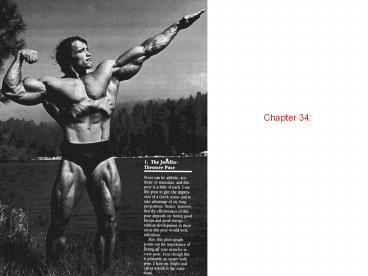Z333 Lecture - PowerPoint PPT Presentation
Title:
Z333 Lecture
Description:
Action and Support: The Muscles and Skeleton Chapter 34: Muscular and Skeletal System Muscle Tissue (Muscle = little mouse ): Composed of single cell type ... – PowerPoint PPT presentation
Number of Views:114
Avg rating:3.0/5.0
Title: Z333 Lecture
1
Chapter 34 Action and Support The Muscles and
Skeleton
2
Chapter 34 Muscular and Skeletal System
Muscle Tissue (Muscle little mouse)
- Composed of single cell type
- Exerts force by contracting (shortening)
1) Produce movement 2) Maintain posture 3)
Support soft tissue (e.g. abdominal wall)
4) Guard entrance / exit (e.g. lips / anus) 5)
Maintain body temperature (e.g. shivering)
3
Chapter 34 Muscular and Skeletal System
Types of Muscle Tissue
Striated
Striated
Not Striated
Skeletal Movement
Move Substances Through Hollow Tubes
Pump Blood
Many
One
One
Slow to Fast
Intermediate
Slow
Voluntary
Involuntary
Involuntary
4
Chapter 34 Muscular and Skeletal System
1) Skeletal Muscle
- Human Body gt 700 unique skeletal muscles
- Muscle structure and function are closely
linked - Tendon Attach muscle to skeleton (Connective
Tissue) - Whole muscle consists of
1) Muscle Fiber Bundles 2) Blood
vessels/Nerves 3) Connective Tissue Wrap
Muscle Fiber Muscle Cell
(Figure 34.1)
5
Chapter 34 Muscular and Skeletal System
Microanatomy of Muscle
Each Muscle Fiber Contains
- T-tubules Network of passageways through fiber
(conduct APs) - Sacroplasmic Reticulum Specialized endoplasmic
reticulum - Contain calcium ions (Ca)
- Myofibrils Cylindrical structures containing
contractile fibers
6
Chapter 34 Muscular and Skeletal System
Microanatomy of Muscle
Myofibril contractile fibers (protein) 1) Actin
(Thin filament) 2) Myosin (Thick filament)
Sarcomere Repeating units of
myofilaments ( 10,000 / cell)
7
Chapter 34 Muscular and Skeletal System
Microanatomy of Muscle
Interactions between the thick and thin filaments
of sarcomeres are responsible for muscle
contraction
8
Chapter 34 Muscular and Skeletal System
Microanatomy of Muscle
Interactions between the thick and thin filaments
of sarcomeres are responsible for muscle
contraction
9
Chapter 34 Muscular and Skeletal System
Sliding Filament Theory
Microanatomy of Muscle
Interactions between the thick and thin filaments
of sarcomeres are responsible for muscle
contraction
Requires ATP (600 trillion / second / cell)
10
Chapter 34 Muscular and Skeletal System
Plasma Membrane
Cytoplasm
Muscle Contraction Events
1) Acetylcholine (ACh - neurotransmitter)
released from synaptic knob
2) ACh binds to receptors on muscle fiber
generates AP (electrical impulse)
3) Action potential conducted along plasma
membrane
11
Chapter 34 Muscular and Skeletal System
- Neuromuscular Junction
- Neuron ? Muscle fiber (connection)
ACh
ACh
ACh
Plasma Membrane
Cytoplasm
Sarcoplasmic Reticulum
Muscle Contraction Events
4) AP descends into muscle fiber via
T-tubules
5) AP triggers release of Ca from
sarcoplasmic reticulum
Sarcomere of myofibril
6) Ca initiates actin-myosin binding
(cross-bridging)
12
Chapter 34 Muscular and Skeletal System
- Neuromuscular Junction
- Neuron ? Muscle fiber (connection)
ACh
ACh
ACh
Plasma Membrane
Cytoplasm
Sarcoplasmic Reticulum
Muscle Contraction Events
4) AP descends into muscle fiber via
T-tubules
5) AP triggers release of Ca from
sarcoplasmic reticulum
Sarcomere of myofibril
6) Ca initiates actin-myosin binding
(cross-bridging)
13
Chapter 34 Muscular and Skeletal System
- Neuromuscular Junction
- Neuron ? Muscle fiber (connection)
ACh
ACh
ACh
Plasma Membrane
Cytoplasm
Sarcoplasmic Reticulum
Muscle Contraction Events
4) AP descends into muscle fiber via
T-tubules
5) AP triggers release of Ca from
sarcoplasmic reticulum
Sarcomere of myofibril
6) Ca initiates actin-myosin binding
(cross-bridging)
14
Chapter 34 Muscular and Skeletal System
Control of Skeletal Muscle Contractions
1) Length of Muscle Contraction ? AP Frequency
15
Chapter 34 Muscular and Skeletal System
Control of Skeletal Muscle Contractions
1) Strength of Muscle Contraction ? of Fibers
Stimulated
Motor Unit A single motor neuron and all the
muscle fibers innervated by
it (motor unit all-or-none)
- Motor unit size dictates control
- Fine Control 1-5 fibers (eye)
- Gross Control 1000s fibers (leg)
16
Chapter 34 Muscular and Skeletal System
Skeletal System
- Supporting framework for the body
- Types of Animal Skeletons
- 1) Hydrostatic Skeleton (e.g. earthworm,
mollusk) - Fluid-filled compartments provides support
- 2) Exoskeleton (e.g. insects, crustaceans)
- Rigid, external skeleton supporting body
- 3) Endoskeleton (e.g. humans)
- Rigid, internal skeleton supporting body
17
Chapter 34 Muscular and Skeletal System
Human Skeleton 206 bones
- Axial skeleton
- Skull, vertebral column, rib cage
- Appendicular Skeleton
- Extremities
Functions
- 1) Supports body / protects organs
- 2) Locomotion
- 3) Blood cell production (red bone marrow)
- 4) Storage site
- Calcium and Phosphorus
- Energy (yellow bone marrow)
- 5) Sensory transduction (e.g. inner ear)
(Figure 34.6)
18
Chapter 34 Muscular and Skeletal System
Skeletal Tissue Types
- Provides flexible support / connections
- a) Forms skeleton (early development)
- b) Covers end of bones (joints)
- c) Forms nose / ears
- d) Connects ribs to sternum
- e) Forms shock-absorbing pads (e.g.
intervertebral discs) - Consists of living cells (chondrocytes) in
protein matrix
- No direct blood supply
19
Chapter 34 Muscular and Skeletal System
Skeletal Tissue Types
2) Bone (connective tissue)
- Provides strong, rigid framework
- Consists of
- a) Collagen fibers (hardened with calcium
phosphate deposits) - b) Osteoblasts (build bone)
- c) Osteocytes (mature bone cells)
- d) Osteoclasts (dissolve bone)
- Bone is constantly remodeled (5 - 10 each year)
20
Chapter 34 Muscular and Skeletal System
Types of Bones
1) Compact bone
- Hard, outer shell
- Site of muscle attachment
2) Spongy bone
- Interior latticework (porous)
- Contains bone marrow
- Bone density reaches peak
- at age 35
- Predominates in women (8x)
- Treatment
- Exercise Ca supplements
- Hormone replacement therapy
21
Chapter 34 Muscular and Skeletal System
Body Movement
- Ligament Fibrous connective tissue
attaching bones - Antagonistic muscles drive movement
- Flexion Decrease angle between bones
- Extension increase angle between bones
Types of Joints
- 1) Hinge joint
- 2 - demensional movement (e.g. knee)
- 1) Ball-and-socket joint
- 3 - demensional movement (e.g. hip)

























